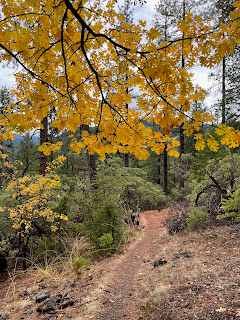Last week, I cut down a little fir tree close to my house and brought it inside. Then I invited a friend to come over for eggnog and tree trimming. It's not a modern Christmas tree, with a perfect cone shape and tight limbs. It's a wild tree. The ornaments don't nestle into branches; they dangle where you can see them. (Look for the origami and other decades-old, hand-made ornaments in the picture.) I found the the tree growing trunk-to-trunk next to a large ponderosa pine. With truncated back branches it nestles close to the banister, allowing walking room to the pantry and the bathroom.
The Christmas trees in the larger house of my childhood were always ceiling-high and broad-limbed, as Christmas trees from lots were in those days. We, too, had ornaments from long ago, such as twisted tin dangles made from tin cans during World War II. Tinsel had to be hung one strand at a time, the way I still do it. Every year, when the tree was trimmed, my mother would stand back and say, "It's the most beautiful tree we've ever had."
One year my father built a five-foot-tall Christmas star. Every year after that he would lay the metal strips, screwed into a star shape, on the floor and string the large-bulb, multi-colored lights along the points. Then he would climb onto the roof and erect the star at the peak. Every evening during the Christmas season, we would plug in the star just at dusk. We couldn't see it, but we knew people driving down the road could. (After a while, Dad just left the star on the roof, unlit until the Christmas season.)
We were so proud of that star! When we had been out and were driving home, down the long, dark hill of Long Island Drive, we eagerly looked for it. We were probably at least a mile away and still high on the hill when we spotted it, colorful and bright and big, asserting itself alone through the distance, in the dark. No other Christmas lights were visible, just our star. We thought it was thrilling.
It was that kind of family. Not that we had to have the best of everything but that what we had was so often what we had created. Other houses were more grand, but ours was the Coogle home. Other Christmas lights were more elaborate, but ours was a Coogle star.












































